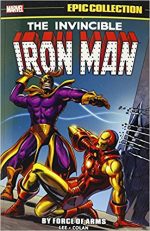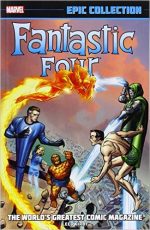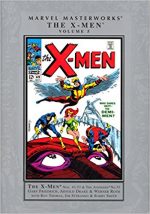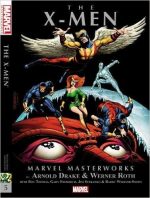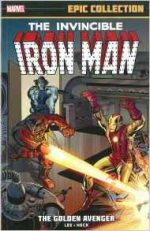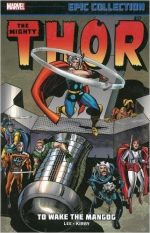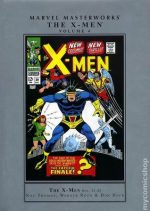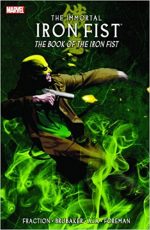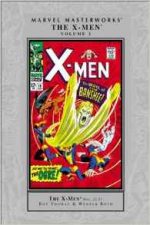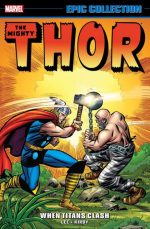

By Roy Thomas, Denny O’Neil, Arnold Drake, Don Heck, Werner Roth, Neal Adams, Sal Buscema, Tom Palmer, Sam Grainger, Vince Colletta & various (Marvel)
ISBN: 978-0-7851-2056-8(HB)Â Â Â Â Â Â Â Â Â Â Â Â Â Â Â Â Â Â Â Â Â Â Â Â Â Â Â Â Â Â Â Â 978-0-7851-8837-7(PB)
X-Men was never Marvel’s top seller but did secure a devout and dedicated following, with the frantic, freakish energy of Jack Kirby’s heroic dynamism comfortably transiting into the slick, sleek prettiness of Werner Roth as the blunt tension of hunted outsider kids settled into a pastiche of the college and school scenarios so familiar to the students who were the series’ main audience. As the decade progressed the kids got edgier and more angst-ridden – as did the world around them and their readers – and the sense of pent-up aggression, isolation and alienation grew.
The core team still consisted of tragic leader Scott Summers/Cyclops, ebullient Bobby Drake/Iceman, wealthy golden boy Warren Worthington/Angel and erudite, brutish genius Henry McCoy/Beast although they were now without Professor Charles Xavier, the wheelchair-bound telepath dedicated to brokering peace and integration between the masses of humanity and the gradually emerging race of mutant Homo Superior.
Jean Grey/Marvel Girl had recently taken up much of the professor’s role and the team was also occasionally supplemented by magnetic minx Polaris, although she was usually referred to as Lorna Dane…
However, by the time of this final collection (re-presenting X-Men #54-66 from March 1969 to March 1970) of the turbulent teens’ original series, despite some of the most impressive and influential stories and art of the decade, the writing was definitely on the wall for Marvel’s misunderstood mutants…
The mayhem begins with ‘Wanted: Dead or Alive… Cyclops!’ by Arnold Drake, Don Heck & Vince Colletta, which introduces Scott’s kid brother Alex just in time for the lad to be kidnapped by Egyptian acolytes of emergent Homo Superior The Living Pharaoh. It appears the boy has a hidden power the Pharaoh covets, which necessitates framing the X-Men’s leader…
At that time the back of the X-Men comic was running “untold origins†of the team, and ‘The Million Dollar Angel’ (Drake & Werner Roth) began unfolding the background of Warren Worthington III, a precocious rich boy rushed off to prep school where he grew wings and concealed them by making himself the most despised and lonely person on campus…
Roy Thomas returned as scripter for #55’s ‘The Living Pharaoh!’ – illustrated by Don Heck, Roth & Colletta – as the full team follow the Summers brothers to the Valley of the Kings and soundly thrash the faux potentate’s minions, only to have the new mutant’s unsuspected power go wild.
Meanwhile, in ‘Where Angels Fear to Tread!’ (Thomas, Roth & Sam Grainger) little Warren has left school and plans a superhero career until an atomic accident brings him into contact with a couple of kids code-named Cyclops and Iceman…
Nobody knew it at the time – and sales certainly didn’t reflect it – but with X-Men #56 superhero comics changed forever. Neal Adams had stunned the comics-buying public with his horror anthology work and revolutionary art on Green Lantern/Green Arrow and Batman, but here, with writer Thomas in iconoclastic form, they began to expand the horizons of graphic narrative with a succession of boldly innovative, tensely paranoid dramas that pitted mutants against an increasingly hostile world.
Deliberately pitched at an older audience, a run of gripping, addictively beautiful epics captivated and enchanted a small band of amazed readers – and were completely ignored by the greater mass of the buying public. Without these tales, the modern X-phenomenon could not have existed, but they couldn’t save the series from cancellation. The cruellest phrase in comics is “ahead of its time…â€
‘What is… the Power?’ (Thomas, Adams & inker extraordinaire Tom Palmer) reveals an uncanny connection between the Pharaoh and Alex and, as the Egyptian mastermind transformed into a colossal Living Monolith, the terrified boy’s mutant energies are unleashed with catastrophic results…
At the back, a chemically unbalanced Angel becomes ‘The Flying A-Bomb!’ but happily is defused in time to become the newest X-Man.
Issue #57 brought back the team’s most relentless adversaries in ‘The Sentinels Live!’ as a public witch-hunt prompts the mutant-hunting robots to pursue X-Men across the globe. Amongst the first victims are magnetic Lorna Dane and Alex but the sinister Sentinels have their unblinking optics set on all mutants…
That issue also saw a rundown on Marvel Girl’s abilities in the last back-up feature ‘The Female of the Species!’.
From the next issue on, Thomas and Adams would have an entire issue to play with…
‘Mission: Murder!’ ramps up the tension as the toll of fallen mutants increases, with Iceman, the Pharaoh, Angel and Mesmero all falling to the murderous mechanoids, but when their human controller discovers an unsuspected secret the automatons strike out on their own…
With all other mutants in the Marvel universe captured, Cyclops, Marvel Girl and Beast are reduced to a suicidal frontal assault in ‘Do or Die, Baby!’; pulling off a spectacular victory, but only at the cost of Alex, now calling himself Havok…
Badly injured, Alex is brought to an old colleague of Professor Xavier’s named Karl Lykos – a discreet physician hiding a dark secret. ‘In the Shadow of Sauron!’ reveals that as a child the not-so-good doctor had been bitten by Pterodactyls from the Antarctic Savage Land and become an energy vampire.
Now with a powerful mutant to feed on, his addiction fully manifests and a sated Lykos transforms into a winged saurian with hypnotic powers, determined to gorge himself on the other X-Men.
After a shattering struggle in ‘Monsters Also Weep!’ Lykos is defeated and instinctively flees South to the Savage Land to die. Drained of his power, he reverts to human form and when the X-Men track him down the tormented leech chooses suicide rather than become Sauron once more.
Searching for his body, Angel is also attacked by Pteranodons and crashes to the bottom of a vast crevasse, precipitating the mutants into another primordial encounter with wild man Ka-Zar as ‘Strangers …in a Savage Land!’
Marooned once more in a lost world, Angel is healed by the enigmatic Creator: a wounded genius protecting the Savage Land’s mutant population with his own team of X-Men counterparts.
As his team-mates search for him, the Winged Wonder switches allegiance, unaware that his benefactor is actually the X-Men’s oldest enemy…
‘War in the World Below!’ sees the villain’s plans revealed and finally thwarted by the heroes and Ka-Zar, leaving the returning team to tackle a controversial Japanese extremist in ‘The Coming of Sunfire!’ (#64, with veteran stalwart Don Heck doing an impressive fill-in job for Adams) whilst the next issue resurrects the long-dead Professor Xavier – only to nearly kill him again in the Denny O’Neil scripted alien-invasion yarn ‘Before I’d Be Slave…’: an astounding epic that ended Adams’ artistic tenure in grand style.
All the staffing changes were hints of a bigger shake-up. With X-Men #66 (March 1970), the series was cancelled, despite all the frantic and radical innovations crafted by a succession of supremely talented creators.
‘The Mutants and the Monster’, by Thomas, Sal Buscema & Grainger, sent the team hunting for Bruce Banner in an attempt to save Professor X from a coma induced by his psychic battle against the aliens. Unfortunately, when you hunt Banner what you usually end up with is an irate Incredible Hulk…
Although gone, the mutants were far from forgotten. The standard policy at that time to revive characters that had fallen was to pile on the guest-shots and reprints. X-Men #67 (December 1970) saw them return, re-presenting early classics.
The Beast fared better than his buddies: riding a wave of monster titles, he was reinvented in a solo series as a response to the world horror boom which shifted general comicbook fare from bright shiny costumed heroes to dark and sinister monsters.
Blue, furry and misunderstood, he soldiered on in various venues until the X-Men stormed back in 1975, but that’s all meat for different collections…
Although a little scrappy in places, these disparate stories are wonderful comics sagas that were too radical for the readership of the times but have since been acknowledged as groundbreaking mini-masterpieces which reshaped the way we tell stories to this day: making this comprehensive collection an unquestionable treasure no fan should be without.
© 1969, 1970, 2016 Marvel Characters, Inc. All rights reserved.

